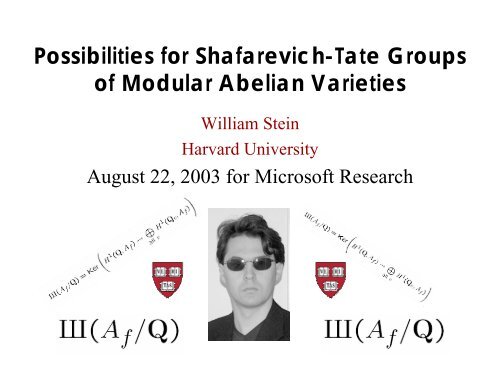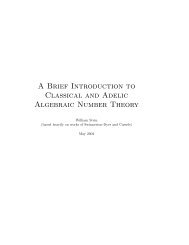Possibilities for Shafarevich-Tate Groups of Modular ... - William Stein
Possibilities for Shafarevich-Tate Groups of Modular ... - William Stein
Possibilities for Shafarevich-Tate Groups of Modular ... - William Stein
You also want an ePaper? Increase the reach of your titles
YUMPU automatically turns print PDFs into web optimized ePapers that Google loves.
<strong>Possibilities</strong> <strong>for</strong> <strong>Shafarevich</strong>-<strong>Tate</strong> <strong>Groups</strong><br />
<strong>of</strong> <strong>Modular</strong> Abelian Varieties<br />
<strong>William</strong> <strong>Stein</strong><br />
Harvard University<br />
August 22, 2003 <strong>for</strong> Micros<strong>of</strong>t Research
Overview <strong>of</strong> Talk<br />
1. Abelian Varieties<br />
2. <strong>Shafarevich</strong>-<strong>Tate</strong> <strong>Groups</strong><br />
3. Nonsquare <strong>Shafarevich</strong>-<strong>Tate</strong> <strong>Groups</strong>
Abelian Varieties<br />
Abelian Variety: A projective group variety<br />
(group law is automatically abelian).<br />
Examples:<br />
1. Elliptic curves<br />
2. Jacobians <strong>of</strong> curves<br />
3. <strong>Modular</strong> abelian varieties<br />
4. Weil restriction <strong>of</strong> scalars
Jacobians <strong>of</strong> Curves<br />
If X is an algebraic curve then<br />
Jac(X) = { divisor classes <strong>of</strong> degree 0 on X }.<br />
Example: Let X 1(N) be the modular curve<br />
parametrizing pairs<br />
(E, embedding <strong>of</strong> Z/NZ into E).<br />
The Jacobian <strong>of</strong> X 1(N) is J 1(N).
The <strong>Modular</strong> Jacobian J 1 (N)<br />
• J 1 (N) = Jacobian <strong>of</strong> X 1 (N)<br />
•The Hecke Algebra:<br />
• Cuspidal <strong>Modular</strong> Forms:
<strong>Modular</strong> Abelian Varieties<br />
A modular abelian variety is any quotient <strong>of</strong> J 1 (N).<br />
Goro Shimura associated an abelian<br />
variety A f to any new<strong>for</strong>m f:<br />
where
Extra structure<br />
• A is an abelian variety over Q<br />
• The ring Z[a 1,a 2,…] is a subring <strong>of</strong> End(A)<br />
•The dimension <strong>of</strong> A equals the degree <strong>of</strong> the<br />
field generated by the a n
They Are Interesting!<br />
• Wiles et al.: Every elliptic curve<br />
over Q is modular, i.e., isogenous to an A f<br />
Consequence (Ribet): Fermat’s Last Theorem<br />
• Serre’s Conjecture: Every odd irreducible Galois representation<br />
occurs up to twist in the torsion points <strong>of</strong> some A f
Weil Restriction <strong>of</strong> Scalars
Birch and Swinnerton-Dyer
BSD Conjecture
The <strong>Shafarevich</strong>-<strong>Tate</strong><br />
Group <strong>of</strong> A f<br />
Sha is a subgroup <strong>of</strong> the first Galois cohomology<br />
<strong>of</strong> A f that measures failure <strong>of</strong> “local to global”:<br />
Example:<br />
Conjecture (<strong>Shafarevich</strong>-<strong>Tate</strong>):<br />
is finite.
The <strong>Shafarevich</strong>-<strong>Tate</strong> Group
Finiteness Theorems <strong>of</strong> Kato,<br />
Kolyvagin, Logachev, and Rubin
The Dual Abelian Variety<br />
The dual <strong>of</strong> A is an abelian variety isogenous to<br />
A that parametrizes classes <strong>of</strong> invertible sheaves<br />
on A that are algebraically equivalent to zero.<br />
The dual is functorial:
Polarized Abelian<br />
Varieties<br />
A polarization <strong>of</strong> A is an isogeny (homomorphism) from A<br />
to its dual that is induced by a divisor on A. A polarization<br />
<strong>of</strong> degree 1 is called a principal polarization.<br />
Theorem. If A is the Jacobian <strong>of</strong> a curve, then A is<br />
canonically principally polarized. For example, elliptic<br />
curves are principally polarized.
Cassels-<strong>Tate</strong> Pairing
What if the abelian variety<br />
A is not an elliptic curve?<br />
Assume is finite. Overly optimistic literature:<br />
• Page 306 <strong>of</strong> [<strong>Tate</strong>, 1963]: If A is a Jacobian then<br />
• Page 149 <strong>of</strong> [Swinnerton-Dyer, 1967]: <strong>Tate</strong> proved that
Michael Stoll’s<br />
Computation<br />
During a grey winter day in 1996,<br />
Michael Stoll sat puzzling over a<br />
computation in his study on a<br />
majestic embassy-peppered hill<br />
near Bonn overlooking the Rhine.<br />
He had implemented an algorithm<br />
<strong>for</strong> computing 2-torsion in <strong>Shafarevich</strong>-<strong>Tate</strong> groups <strong>of</strong> Jacobians<br />
<strong>of</strong> hyperelliptic curves. He stared at a curve X <strong>for</strong> which his<br />
computations were in direct contradiction to the previous slide!<br />
What was wrong????
Poonen-Stoll<br />
From: Michael Stoll (9 Dec 1996)<br />
Dear Bjorn, Dear Ed:<br />
[...] your results would imply that Sha[2] = Z/2Z<br />
in contradiction to the fact that the order <strong>of</strong> Sha[2] should<br />
be a square (always assuming, as everybody does, that Sha is finite).<br />
So my question is (<strong>of</strong> course): What is wrong ?<br />
From: Bjorn Pooenen (9 Dec 96)<br />
Dear Michael:<br />
Thanks <strong>for</strong> your e-mails. I'm glad someone is actually taking the time<br />
to think about our paper critically! [...]<br />
I would really like to resolve the apparent contradiction,<br />
because I am sure it will end with us learning something!<br />
(And I don't think that it will be that Sha[2] can have odd dimension!)<br />
From: Bjorn Poonen (11 hours later)<br />
Dear Michael:<br />
I think I may have resolved the problem. There is nothing wrong with<br />
the paper, or with the calculation. The thing that is wrong is the<br />
claim that Sha must have square order!
Poonen-Stoll Theorem<br />
Theorem (Annals, 1999): Suppose J is the Jacobian <strong>of</strong> a curve<br />
and J has finite <strong>Shafarevich</strong>-<strong>Tate</strong> group. Then<br />
Example: The Jacobian <strong>of</strong> this curve has Sha <strong>of</strong> order 2
Is Sha Always Square or<br />
Twice a Square?<br />
Poonen asked at the Arizona Winter<br />
School in 2000, “Is there an abelian<br />
variety A with <strong>Shafarevich</strong>-<strong>Tate</strong> group<br />
<strong>of</strong> order three?”
In 2002 I finally found Sha <strong>of</strong> order 3<br />
(times a square):
Plenty <strong>of</strong> Nonsquare Sha!<br />
• Theorem (<strong>Stein</strong>): For every prime<br />
p < 25000 there is an abelian variety<br />
A over Q such that<br />
• Conjecture (<strong>Stein</strong>): Same statement <strong>for</strong> all p.
Constructing Nonsquare Sha<br />
While attempting to connect groups <strong>of</strong> points on<br />
elliptic curves <strong>of</strong> high rank to <strong>Shafarevich</strong>-<strong>Tate</strong> groups<br />
<strong>of</strong> abelian varieties <strong>of</strong> rank 0, I found a construction <strong>of</strong><br />
nonsquare <strong>Shafarevich</strong>-<strong>Tate</strong> groups.
The Main Theorem<br />
Theorem (<strong>Stein</strong>). Suppose E is an elliptic curve and p an odd<br />
prime that satisfies various technical hypothesis. Suppose l is a<br />
prime congruent to 1 mod p (and not dividing N E ) such that<br />
Here is a Dirichlet character <strong>of</strong> order p<br />
and conductor l corresponding to an abelian extension K. Then<br />
there is a twist A <strong>of</strong> a product <strong>of</strong> p - 1 copies <strong>of</strong> E and an exact<br />
sequence<br />
If E has odd rank and is finite then<br />
has order that is not a perfect square.
What is the Abelian Variety A?<br />
Let R be the Weil restriction <strong>of</strong> scalars <strong>of</strong> E from K down to Q, so R<br />
is an abelian variety over Q <strong>of</strong> dimension p (i.e., the degree <strong>of</strong> K).<br />
Then A is the kernel <strong>of</strong> the map induced by trace:<br />
Note that<br />
• A has dimension p –1<br />
• A is isomorphic over K to a product <strong>of</strong> copies <strong>of</strong> E<br />
• Our hypothesis on and Kato’s finiteness theorems imply that<br />
A(Q) and are both finite.
Pro<strong>of</strong> Sketch (1): Exact<br />
Sequence <strong>of</strong> Neron Models
Pro<strong>of</strong> (2): Mazur’s Etale<br />
Cohomology Sha Theorem<br />
Mazur's Rational Points <strong>of</strong> Abelian Varieties with<br />
Values in Towers <strong>of</strong> Number Fields:<br />
In general this is not true, but our hypothesis on p and l<br />
are exactly strong enough to kill the relevant error terms.
Pro<strong>of</strong> (3): Long Exact Sequence<br />
The long exact sequence <strong>of</strong> étale cohomology begins<br />
Take the p-power torsion in this exact sequence then use<br />
Mazur’s theorem. Next analyze the cokernel <strong>of</strong> δ…
Pro<strong>of</strong> (4): Apply Kato’s<br />
Finiteness Theorems<br />
(To see this requires chasing some diagrams.)<br />
Both <strong>of</strong> these steps use Kato’s finiteness theorem in an essential way.<br />
Putting everything together yields the claimed exact sequence
What Next?<br />
• Remove the hypothesis that p
Acknowledgements:<br />
Thank you <strong>for</strong> coming!<br />
Kevin Buzzard, Cristian Gonzalez, Barry Mazur,<br />
Bjorn Poonen, Ken Ribet, and Michael Stoll<br />
For more details including an accepted paper:<br />
http://modular.fas.harvard.edu/papers/nonsquaresha/.
















